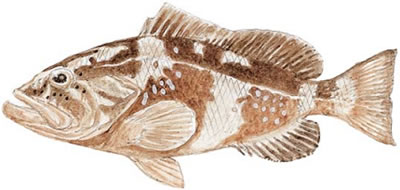The red grouper was one of the most abundant grouper in the Caribbean and surrounding waters until spearfishing and general overfishing depleted its numbers.
Identification
Of varying coloration, the red grouper is usually dark brownish-red, especially around the mouth, and may have dark bars and blotches similar to those on the Nassau grouper, as well as a few small whitish blotches scattered in an irregular pattern. It is distinguished from the Nassau grouper by its lack of a saddle spot and its smooth, straight front dorsal fin.
On the Nassau grouper the dorsal fin is notched. It has a blackish tinge to the soft dorsal, the anal, and the tail fins; pale bluish margins on the rear dorsal, the anal, and the tail fins; and small black spots around the eyes. The lining of the mouth is scarlet to orange. The second spine of the dorsal fin is longer than the others, the pectoral fins are longer than the pelvic fins, and the tail is distinctively squared off.
Size/Age
The red grouper is commonly 1 to 2 feet long and weighs up to 15 pounds, although it can reach 3.5 feet and 50 pounds. The male red grouper lives longer than the female does and has been known to live for 25 years.
Spawning behavior
Like many other grouper, red grouper undergo a sex reversal; females transform into males, in this case between ages 7 and 14, or when they are 18 to 26 inches long. Spawning takes place from March through July, with a flurry of activity in April and May, in water temperatures ranging from 63° to 77°F and in depths between 80 and 300 feet.
Food and feeding habits
Red grouper feed on a wide variety of fish, invertebrates, and crustaceans, including squid, crabs, shrimp, lobsters, and octopus.
Other Names
grouper; Portuguese: garoupa de Sao Tomé; Spanish: cherna americana, cherna de vivero, mero americano, mero paracamo.
Distribution
In the western Atlantic, red grouper range from North Carolina to southern Brazil, including the Gulf of Mexico, the Caribbean, and Bermuda; some fish stray as far as Massachusetts. They are found only occasionally in Florida and the Bahamas and rarely in the Caribbean.
Habitat
Red grouper are bottom-dwelling fish, occurring over rocky and muddy bottoms, at the margins of seagrass beds, and in ledges, crevices, and caverns of rocky limestone reefs; they are uncommon around coral reefs. They prefer depths of 6 to 400 feet, although they more commonly hold between 80 and 400 feet. Red grouper are usually solitary, resting on the bottom and blending with their surroundings.


